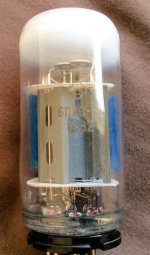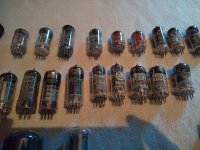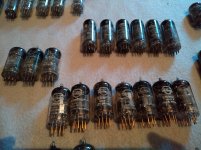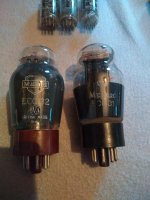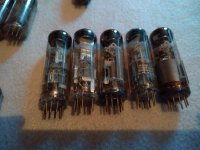What's up guys, just been on a job today and I've been emptying out some old storage sheds. I came across a bag full of tubes and was wondering if there is any way of testing them without having to spend loads on a testing kit?
The valves are mostly mullards, an ecc32, ecc31, em84 etc. There's quite a few and it would be a shame to just throw them. Any help would be great.
Thanks
Adam
The valves are mostly mullards, an ecc32, ecc31, em84 etc. There's quite a few and it would be a shame to just throw them. Any help would be great.
Thanks
Adam
A few pictures and/or a list of numbers and how many would help.
Valves can be pennies to many hundreds of pounds depending on their use / usefulness..
The ECCxx types will get people excited. In my opinion, little point in testing them. Just weed out the ones that have gone 'white' inside, they are dead.
Like this:-
Valves can be pennies to many hundreds of pounds depending on their use / usefulness..
The ECCxx types will get people excited. In my opinion, little point in testing them. Just weed out the ones that have gone 'white' inside, they are dead.
Like this:-
Attachments
You might be able to sell the whole bag for a few bucks, but it's tough to know what you have without doing the legwork of listing, then testing them.
The EM84 is a "magic eye" that can be used as a visual peak meter. Those are cool.

The EM84 is a "magic eye" that can be used as a visual peak meter. Those are cool.

Last edited:
Thanks guys. I've had a look and none of them have gone white like in the picture. I looked into a tester but didn't know which would be compatible, nor did I wanna fork out 200 quid for one. I'll post a list and a few pics if anyone is interested?
I am gonna look to see if anyone has a tester near me I could possibly test them on.
I will list what I have to see if it is worth it for me to test them.
The mullards I have are
ECC 31, 32, 33, 80, 81, 82, 83, 85, 88
E88CC
ECL80, 86
DAF 96
Also have some brimar, Raytheon, valvo, miniwatt and Telefunken?
I will list what I have to see if it is worth it for me to test them.
The mullards I have are
ECC 31, 32, 33, 80, 81, 82, 83, 85, 88
E88CC
ECL80, 86
DAF 96
Also have some brimar, Raytheon, valvo, miniwatt and Telefunken?
That looks to be a good find. In particular from that list, the ECC31, ECC32, and ECC33 are quite valuable, depending on the physical condition and test results. A good condition and strong testing ECC32 could net you 150-200GBP.
The other brands you listed are also sought after, especially Telefunken, but again, it all depends on the valve model and condition/test results. Some valves are useful for audio and are in high demand, others are not.
It's worth pursuing though, if the results are favorable, could be a few hundred GBP worth of valves. An eBay listing with the whole lot sold untested would still fetch a decent price at auction. Or find your local valve enthusiast, gift them and make his/her day 😛
The other brands you listed are also sought after, especially Telefunken, but again, it all depends on the valve model and condition/test results. Some valves are useful for audio and are in high demand, others are not.
It's worth pursuing though, if the results are favorable, could be a few hundred GBP worth of valves. An eBay listing with the whole lot sold untested would still fetch a decent price at auction. Or find your local valve enthusiast, gift them and make his/her day 😛
I'm in Lincolnshire & can test em if that's any good, if not join - UK Vintage Radio Repair and Restoration Discussion Forum it's a really good forum and someone nearer you might be able to help.
Andy.
Andy.
There's quite a few and it would be a shame to just throw them. Any help would be great.
I see you're new here, welcome.
Got any photos ?.
If I lived nearby it would be great to have them tested, unfortunately Lincolnshire is quite a way off from me.
I do have some pictures, I'll try and post them again but it wouldn't let me yesterday
Just tried to upload some again and it just keeps loading and doesn't do anything
I do have some pictures, I'll try and post them again but it wouldn't let me yesterday
Just tried to upload some again and it just keeps loading and doesn't do anything
Does this help?
How to attach images to your posts.
If your files are too large you should get a message to that effect.
How to attach images to your posts.
If your files are too large you should get a message to that effect.
That helped loads! These are the best pictures I can get with my terrible phone camera. A picture of the random ones then most of the mullards.
Thanks
Thanks
Attachments
That's a nice stash there, if they are good. E88CC and ECC88 are 6DJ8 equivalents and are one of the most used tubes out there. ECC8x are all used. There must be someone nearby with a tube tester.
ECL86 go for way more money than their worth IMHO... Start by listing them at 1$ on eBay and see!
Very nice find, the Mullard ECC32 is the crown jewel in terms of selling value, in great cosmetic condition too. If it tests reasonably well, that is a 200 GBP sale, especially with the shield logo, tube junkies cannot resist 😀
One simple test you can do to rule out bad tubes - look up the tube datasheets and test for continuity of the heater pins with a digital multimeter. If they are not continuous, they have burnt out and the tubes are not usable. A tube tester will obviously save you the trouble.
One simple test you can do to rule out bad tubes - look up the tube datasheets and test for continuity of the heater pins with a digital multimeter. If they are not continuous, they have burnt out and the tubes are not usable. A tube tester will obviously save you the trouble.
> test for continuity of the heater
Not counting series-string TV tubes---- for every ONE bad-heater(*) tube I have seen, I've had 99 tubes with low current, excess current, excess hiss/cackle, loose parts, microphonic....
I know a heater looks like an incandescent lamp which burned out a LOT, but for various reasons burnt-heater tubes are rare.
(*) The last (almost the only) bad-heater tube I had would NOT be revealed on ohm meter, was uncertain in a tube tester, and took some time in the actual circuit to prove what its problem was. The heater was fine cold but broke contact when hot. The tube was metal so I could not tell by "glow". This is part of why old-storage and estate-sale tubes are not worth much.
Not counting series-string TV tubes---- for every ONE bad-heater(*) tube I have seen, I've had 99 tubes with low current, excess current, excess hiss/cackle, loose parts, microphonic....
I know a heater looks like an incandescent lamp which burned out a LOT, but for various reasons burnt-heater tubes are rare.
(*) The last (almost the only) bad-heater tube I had would NOT be revealed on ohm meter, was uncertain in a tube tester, and took some time in the actual circuit to prove what its problem was. The heater was fine cold but broke contact when hot. The tube was metal so I could not tell by "glow". This is part of why old-storage and estate-sale tubes are not worth much.
- Home
- Amplifiers
- Tubes / Valves
- New to valves
